Berg J.M., Tymoczko J.L., Stryer L. Biochemistry
Подождите немного. Документ загружается.

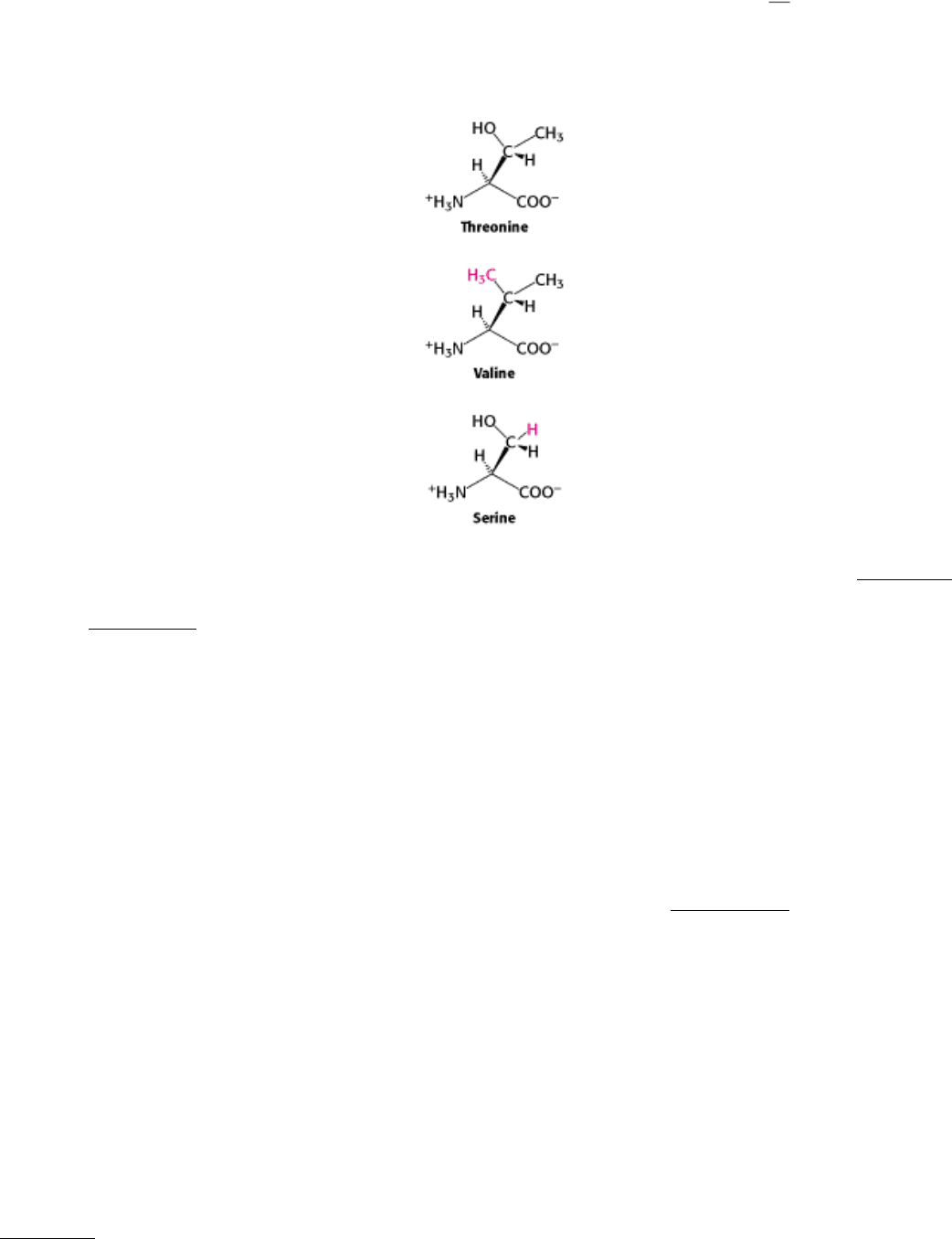
faced by threonyl-tRNA synthetase. Threonine is particularly similar to two other amino acids namely, valine and
serine. Valine has almost exactly the same shape as threonine, except that it has a methyl group in place of a hydroxyl
group. Like threonine, serine has a hydroxyl group but lacks the methyl group. How can the threonyl-tRNA synthetase
avoid coupling these incorrect amino acids to threonyl-tRNA?
The structure of the amino acid-binding site of threonyl-tRNA synthetase reveals how valine is avoided (Figure 29.8).
The enzyme contains a zinc ion, bound to the enzyme by two histidine residues and one cysteine residue. Like carbonic
anhydrase (Section 9.2.1), the remaining coordination sites are available for substrate binding. Threonine coordinates to
the zinc ion through its amino group and its side-chain hydroxyl group. The side-chain hydroxyl group is further
recognized by an aspartate residue that hydrogen bonds to it. The methyl group present in valine in place of this hydroxyl
group cannot participate in these interactions; it is excluded from this active site and, hence, does not become adenylated
and transferred to threonyl-tRNA (abbreviated tRNA
Thr
). Note that the carboxylate group of the amino acid is available
to attack the α-phosphate group of ATP to form the aminoacyl adenylate. Other aminoacyl-tRNA synthetases have
different strategies for recognizing their cognate amino acids; the use of a zinc ion appears to be unique to threonyl-
tRNA synthetase.
The zinc site is less well suited to discrimination against serine because this amino acid does have a hydroxyl group that
can bind to the zinc. Indeed, with only this mechanism available, threonyl-tRNA synthetase does mistakenly couple
serine to threonyl-tRNA at a rate 10
-2
to 10
-3
times that for threonine. As noted in Section 29.1.1, this error rate is likely
to lead to many translation errors. How is a higher level of specificity achieved?
29.2.3. Proofreading by Aminoacyl-tRNA Synthetases Increases the Fidelity of Protein
Synthesis
Threonyl-tRNA synthetase can be incubated with tRNA
Thr
that has been covalently linked with serine (Ser-tRNA
Thr
);
the tRNA has been "mischarged." The reaction is immediate: a rapid hydrolysis of the aminoacyl-tRNA forms serine and
free tRNA. In contrast, incubation with correctly charged Thr-tRNA
Thr
results in no reaction. Thus, threonyl-tRNA
synthetase contains an additional functional site that hydrolyzes Ser-tRNA
Thr
but not Thr-tRNA
Thr
. This editing site
provides an opportunity for the synthetase to correct its mistakes and improve its fidelity to less than one mistake in 10
4
.
The results of structural and mutagenesis studies revealed that the editing site is more than 20 Å from the activation site
(Figure 29.9). This site readily accepts and cleaves Ser-tRNA
Thr
but does not cleave Thr-tRNA
Thr
. The discrimination of
serine from threonine is relatively easy because threonine contains an extra methyl group; a site that conforms to the
structure of serine will sterically exclude threonine.

Most aminoacyl-tRNA synthetases contain editing sites in addition to acylation sites. These complementary pairs of sites
function as a double sieve to ensure very high fidelity. In general, the acylation site rejects amino acids that are larger
than the correct one because there is insufficient room for them, whereas the hydrolytic site cleaves activated species that
are smaller than the correct one.
The structure of the complex between threonyl-tRNA synthetase and its substrate reveals that the aminoacylated-CCA
can swing out of the activation site and into the editing site (Figure 29.10). Thus, the aminoacyl-tRNA can be edited
without dissociating from the synthetase. This proofreading, which depends on the conformational flexibility of a short
stretch of polynucleotide sequence, is entirely analogous to that of DNA polymerase (Section 27.2.4). In both cases,
editing without dissociation significantly improves fidelity with only modest costs in time and energy.
A few synthetases achieve high accuracy without editing. For example, tyrosyl-tRNA synthetase has no difficulty
discriminating between tyrosine and phenylalanine; the hydroxyl group on the tyrosine ring enables tyrosine to bind to
the enzyme 10
4
times as strongly as phenylalanine. Proof-reading has been selected in evolution only when fidelity must
be enhanced beyond what can be obtained through an initial binding interaction.
29.2.4. Synthetases Recognize the Anticodon Loops and Acceptor Stems of Transfer
RNA Molecules
How do synthetases choose their tRNA partners? This enormously important step is the point at which "translation"
takes place
at which the correlation between the amino acid and the nucleic acid worlds is made. In a sense, aminoacyl-
tRNA synthetases are the only molecules in biology that "know" the genetic code. Their precise recognition of tRNAs is
as important for high-fidelity protein synthesis as is the accurate selection of amino acids.
A priori, the anticodon of tRNA would seem to be a good identifier because each type of tRNA has a different one.
Indeed, some synthetases recognize their tRNA partners primarily on the basis of their anticodons, although they may
also recognize other aspects of tRNA structure. The most direct evidence comes from the results of crystallographic
studies of complexes formed between synthetases and their cognate tRNAs. Consider, for example, the structure of the
complex between threonyl-tRNA synthetase and tRNA
Thr
(Figure 29.11). As expected, the CCA arm extends into the
zinc-containing activation site, where it is well positioned to accept threonine from threonyl adenylate. The enzyme
interacts extensively not only with the acceptor stem of the tRNA, but also with the anticodon loop. The interactions with
the anticodon loop are particularly revealing. The bases within the sequence CGU of the anticodon each participate in
hydrogen bonds with the enzyme; those in which G and U take part appear to be more important because the C can be
replaced by G or U with no loss of acylation efficiency. The importance of the anticodon bases is further underscored by
studies of tRNA
Met
. Changing the anticodon sequence of this tRNA from CAU to GGU allows tRNA
Met
to be
aminoacylated by threonyl-tRNA synthetase nearly as well as tRNA
Thr
, despite considerable differences in sequence
elsewhere in the structure.
The structure of another complex between a tRNA and an aminoacyl-tRNA synthetase, that of glutaminyl-tRNA
synthetase, again reveals extensive interactions with both the anticodon loop and the acceptor stem (Figure 29.12). In
addition, contacts are made near the "elbow" of the tRNA molecule, particularly with the base pair formed by G in
position 10 and C in position 25 (denoted position 10:25). Reversal of this base pair from G · C to C · G results in a
fourfold decrease in the rate of aminoacylation as well as a fourfold increase in the K
M
value for glutamine. The results
of mutagenesis studies supply further evidence regarding tRNA specificity, even for aminoacyl-tRNA synthetases for
which structures have not yet been determined. For example, E. coli tRNA
Cys
differs from tRNA
Ala
at 40 positions and
contains a C · G base pair at the 3:70 position. When this C · G base pair is changed to the non-Watson-Crick G · U base
pair, tRNA
Cys
is recognized by alanyl-tRNA synthetase as though it were tRNA
Ala
. This finding raised the question
whether a fragment of tRNA suffices for aminoacylation by alanyl-tRNA synthetase. Indeed, a "microhelix" containing
just 24 of the 76 nucleotides of the native tRNA is specifically aminoacylated by the alanyl-tRNA synthetase. This
microhelix contains only the acceptor stem and a hairpin loop (Figure 29.13). Thus, specific aminoacylation is possible
for some synthetases even if the anticodon loop is completely lacking.
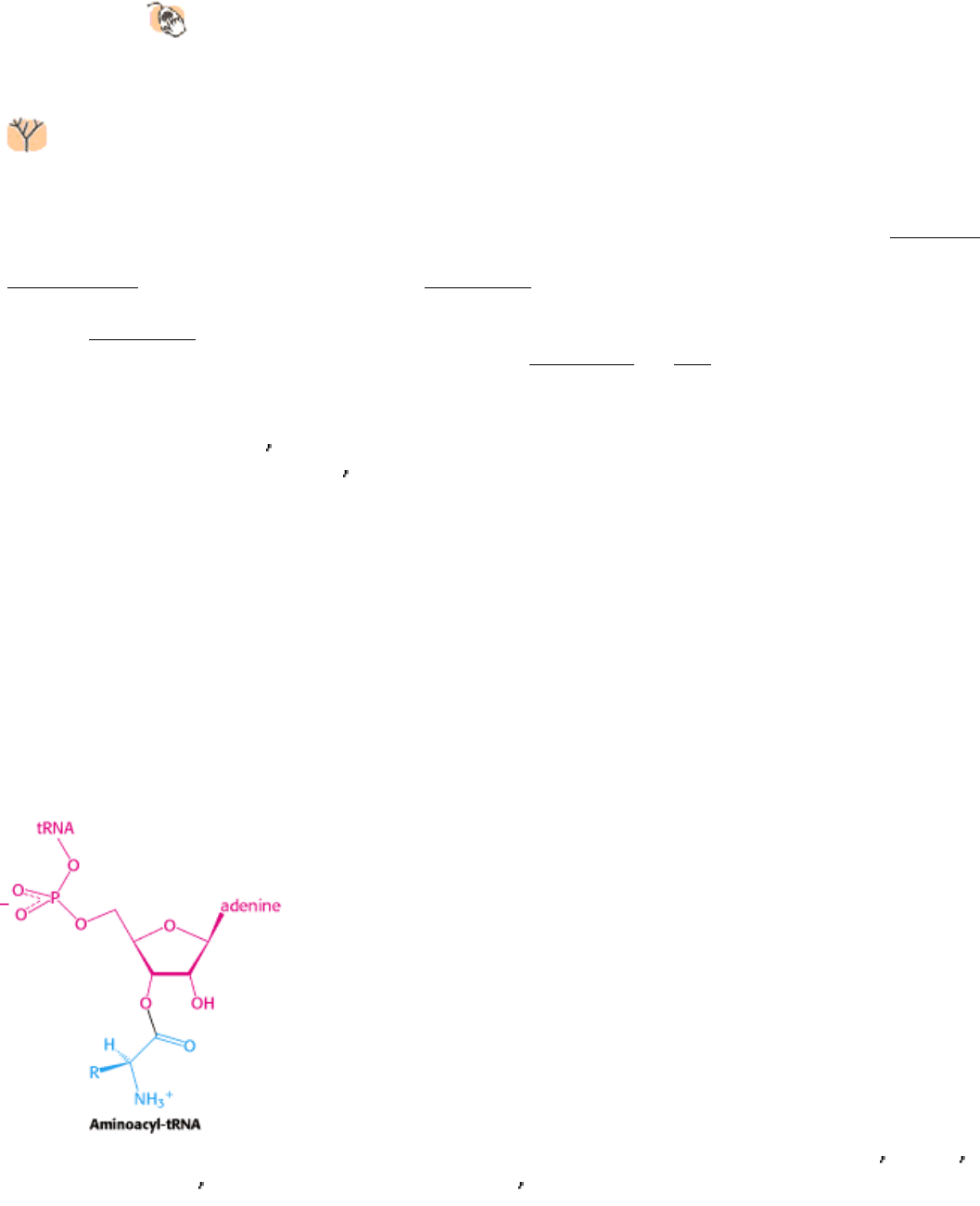
29.2.5. Aminoacyl-tRNA Synthetases Can Be Divided into Two Classes
Structural Insights, Aminoacyl-tRNA Synthetases. The first parts of the
tutorial focus on the structural differences that distinguish class I and class II
aminoacyl-tRNA synthetases. The final section of the tutorial looks at the
editing process that most tRNA synthetases use to correct tRNA acylation
errors.
At least one aminoacyl-tRNA synthetase exists for each amino acid. The diverse sizes, subunit composition, and
sequences of these enzymes were bewildering for many years. Could it be that essentially all synthetases evolved
independently? The determination of the three-dimensional structures of several synthetases followed by more-refined
sequence comparisons revealed that different synthetases are, in fact, related. Specifically, synthetases fall into two
classes, termed class I and class II, each of which includes enzymes specific for 10 of the 20 amino acids (Table 29.2).
Glutaminyl-tRNA synthetase is a representative of class I. The activation domain for class I has a Rossmann fold
(Section 16.1.10). Threonyl-tRNA synthetase (see Figure 29.11) is a representative of class II. The activation domain for
class II consists largely of β strands. Intriguingly, synthetases from the two classes bind to different faces of the tRNA
molecule (Figure 29.14). The CCA arm of tRNA adopts different conformations to accommodate these interactions; the
arm is in the helical conformation observed for free tRNA (see Figures 29.5 and 29.6) for class II enzymes and in a
hairpin conformation for class I enzymes. These two classes also differ in other ways.
1. Class I enzymes acylate the 2 -hydroxyl group of the terminal adenosine of tRNA, whereas class II enzymes (except
the enzyme for Phe-tRNA) acyl-ate the 3
-hydroxyl group.
2. These two classes bind ATP in different conformations.
3. Most class I enzymes are monomeric, whereas most class II enzymes are dimeric.
Why did two distinct classes of aminoacyl-tRNA synthetases evolve? The observation that the two classes bind to
distinct faces of tRNA suggests at least two possibilities. First, recognition sites on both faces of tRNA may have been
required to allow the recognition of 20 different tRNAs. Second, it appears possible that, in some cases, a class I enzyme
and a class II enzyme can bind to a tRNA molecule simultaneously without colliding with each other. In this way,
enzymes from the two classes could work together to modify specific tRNA molecules.
III. Synthesizing the Molecules of Life 29. Protein Synthesis 29.2. Aminoacyl-Transfer RNA Synthetases Read the Genetic Code
Figure 29.7. Aminoacyl-tRNA. Amino acids are coupled to tRNAs through ester linkages to either the 2
- or the 3 -
hydroxyl group of the 3
-adenosine residue. A linkage to the 3 -hydroxyl group is shown.
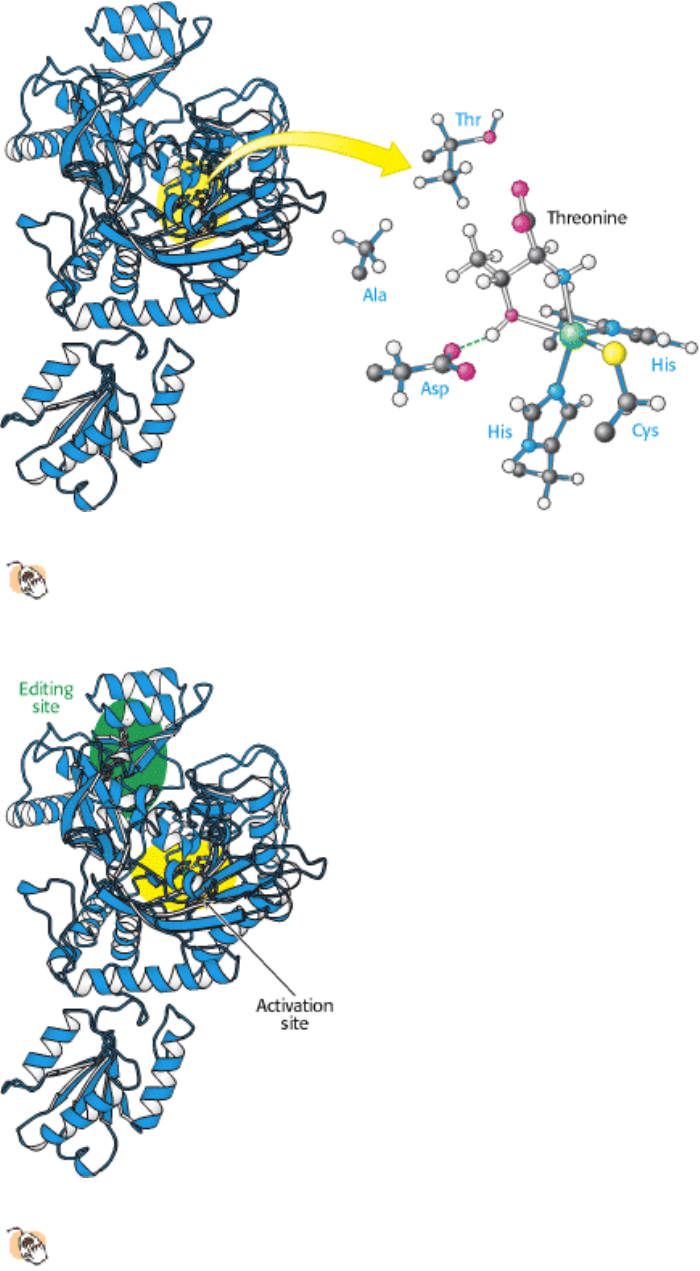
III. Synthesizing the Molecules of Life 29. Protein Synthesis 29.2. Aminoacyl-Transfer RNA Synthetases Read the Genetic Code
Figure 29.8. Structure of Threonyl-tRNA Synthetase.
The structure of a large fragment of threonyl-tRNA synthetase
reveals that the amino acid-binding site includes a zinc ion that coordinates threonine through its amino and
hydroxyl groups. Only one subunit of the dimeric enzyme is shown in this and subsequent figures.
III. Synthesizing the Molecules of Life 29. Protein Synthesis 29.2. Aminoacyl-Transfer RNA Synthetases Read the Genetic Code
Figure 29.9. Editing Site.
The results of mutagenesis studies revealed the position of the editing site (shown in green) in
threonyl-tRNA synthetase.
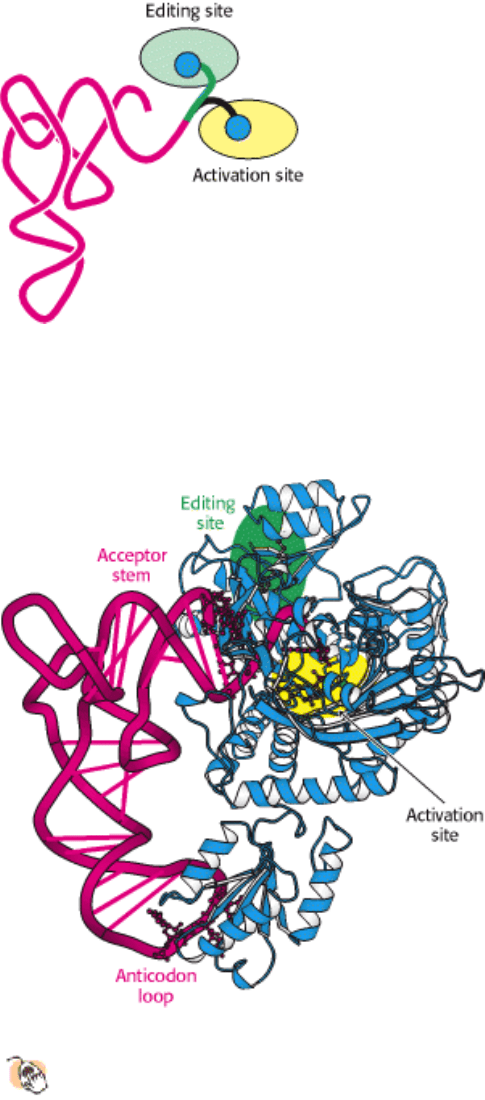
III. Synthesizing the Molecules of Life 29. Protein Synthesis 29.2. Aminoacyl-Transfer RNA Synthetases Read the Genetic Code
Figure 29.10. Editing of Aminoacyl-tRNA. The flexible CCA arm of an aminoacyl-tRNA can move the amino acid
between the activation site and the editing site. If the amino acid fits well into the editing site, the amino acid is removed
by hydrolysis.
III. Synthesizing the Molecules of Life 29. Protein Synthesis 29.2. Aminoacyl-Transfer RNA Synthetases Read the Genetic Code
Figure 29.11. Threonyl-tRNA Synthetase Complex.
The structure of the complex between threonyl-tRNA synthetase
and tRNA
Thr
reveals that the synthetase binds to both the acceptor stem and the anticodon loop.

III. Synthesizing the Molecules of Life 29. Protein Synthesis 29.2. Aminoacyl-Transfer RNA Synthetases Read the Genetic Code
Figure 29.12. Glutaminyl-tRNA Synthetase Complex.
The structure of this complex reveals that the synthetase
interacts with base pair G10:C25 in addition to the acceptor step and anticodon loop.
III. Synthesizing the Molecules of Life 29. Protein Synthesis 29.2. Aminoacyl-Transfer RNA Synthetases Read the Genetic Code
Figure 29.13. Microhelix Recognized by Alanyl-tRNA Synthetase. A stem-loop containing just 24 nucleotides
corresponding to the acceptor stem is aminoacylated by alanyl-tRNA synthetase.
III. Synthesizing the Molecules of Life 29. Protein Synthesis 29.2. Aminoacyl-Transfer RNA Synthetases Read the Genetic Code
Table 29.2. Classification and subunit structure of aminoacyl-tRNA synthetases in E. coli
Class I Class II
Arg (α) Ala (α
4
)
Cys (α) Asn (α
2
)
Gln (α) Asp (α
2
)
Glu (α) Gly (α
2
β
2
)
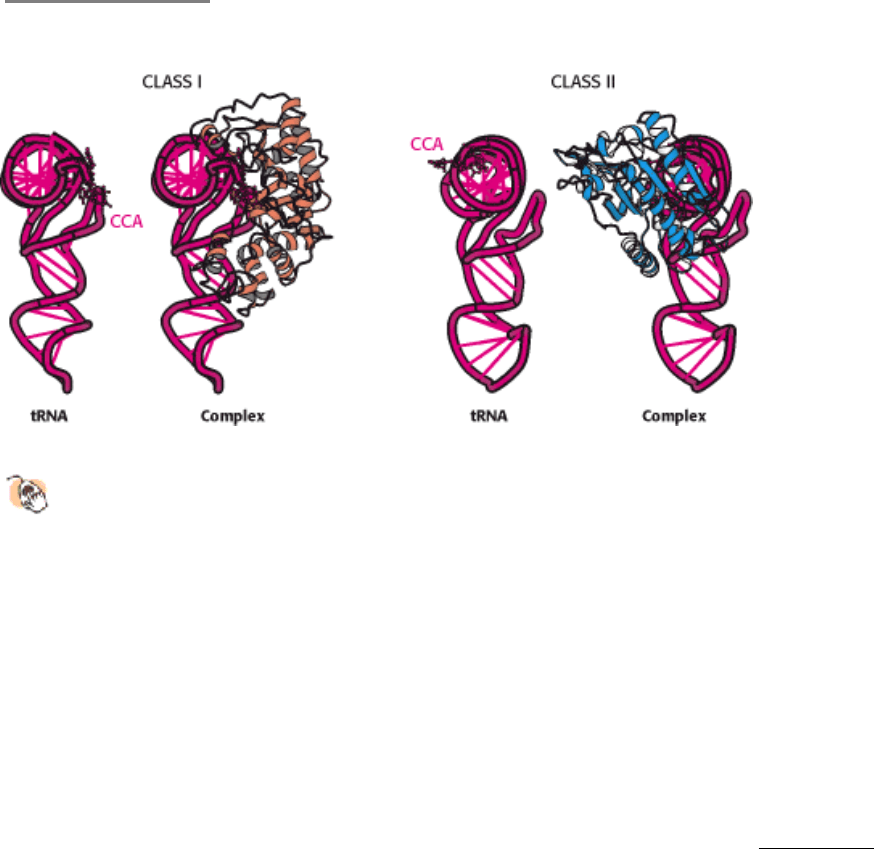
IIe (α) His (α
2
)
Leu (α) Lys (α
2
)
Met (α) Phe (α
2
β
2
)
Trp (α
2
) Ser (α
2
)
Tyr (α
2
) Pro (α
2
)
Val (α) Thr(α
2
)
III. Synthesizing the Molecules of Life 29. Protein Synthesis 29.2. Aminoacyl-Transfer RNA Synthetases Read the Genetic Code
Figure 29.14. Classes of Aminoacyl-tRNA Synthetases.
Class I and class II synthetases recognize different faces of the
tRNA molecule. The CCA arm of tRNA adopts different conformations in complexes with the two classes of
synthetase.
III. Synthesizing the Molecules of Life 29. Protein Synthesis
29.3. A Ribosome Is a Ribonucleoprotein Particle (70S) Made of a Small (30S) and a
Large (50S) Subunit
We turn now to ribosomes, the molecular machines that coordinate the interplay of charged tRNAs, mRNA, and proteins
that leads to protein synthesis. An E. coli ribosome is a ribonucleoprotein assembly with a mass of about 2700 kd, a
diameter of approximately 200 Å, and a sedimentation coefficient of 70S. The 20,000 ribosomes in a bacterial cell
constitute nearly a fourth of its mass.
A ribosome can be dissociated into a large subunit (50S) and a small subunit (30S) (Figure 29.15). These subunits can be
further split into their constituent proteins and RNAs. The 30S subunit contains 21 different proteins (referred to as S1
through S21) and a 16S RNA molecule. The 50S subunit contains 34 different proteins (L1 through L34) and two RNA
molecules, a 23S and a 5S species. A ribosome contains one copy of each RNA molecule, two copies of the L7 and L12
proteins, and one copy of each of the other proteins. The L7 protein is identical with L12 except that its amino terminus
is acetylated. Only one protein is common to both subunits: S20 is identical with L26. Both the 30S and the 50S subunits
can be reconstituted in vitro from their constituent proteins and RNA, as was first achieved by Masayasu Nomura in
1968. This reconstitution is an outstanding example of the principle that supramolecular complexes can form
spontaneously from their macromolecular constituents.
Electron microscopic studies of the ribosome at increasingly high resolution provided views of the overall structure and
revealed the positions of tRNA-binding sites. Astounding progress on the structure of the ribosome has been made by x-
ray crystallographic methods, after the pioneering work by Ada Yonath. The structures of both the 30S and the 50S
subunits have been determined at or close to atomic resolution, and the elucidation of the structure of intact 70S

ribosomes at a similar resolution is following rapidly (Figure 29.16). The determination of this structure requires the
positioning of more than 100,000 atoms. The features of these structures are in remarkable agreement with
interpretations of less-direct experimental probes. These structures provide an invaluable framework for examining the
mechanism of protein synthesis.
29.3.1. Ribosomal RNAs (5S, 16S, and 23S rRNA) Play a Central Role in Protein
Synthesis
The prefix ribo in the name ribosome is apt, because RNA constitutes nearly two-thirds of the mass of these large
molecular assemblies. The three RNAs present
5S, 16S, and 23S are critical for ribosomal architecture and function.
They are formed by cleavage of primary 30S transcripts and further processing. The base-pairing patterns of these
molecules were deduced by comparing the nucleotide sequences of many species to detect conserved features, in
combination with chemical modification and digestion experiments (Figure 29.17). The striking finding is that ribosomal
RNAs (rRNAs) are folded into defined structures with many short duplex regions. This conclusion and essentially all
features of the secondary structure have been confirmed by the x-ray crystallographically determined structures.
For many years, ribosomal proteins were presumed to orchestrate protein synthesis and ribosomal RNAs were
presumed to serve primarily as structural scaffolding. The current view is almost the reverse. The discovery of
catalytic RNA made biochemists receptive to the possibility that RNA plays a much more active role in ribosomal
function. The detailed structures make it clear that the key sites in the ribosome are composed almost entirely of RNA.
Contributions from the proteins are minor. Many of the proteins have elongated structures that "snake" their way into the
RNA matrix (Figure 29.18). The almost inescapable conclusion is that the ribosome initially consisted only of RNA and
that the proteins were added later to fine tune its functional properties. This conclusion has the pleasing consequence of
dodging a "chicken and egg" question namely, How can complex proteins be synthesized if complex proteins are
required for protein synthesis?
29.3.2. Proteins Are Synthesized in the Amino-to-Carboxyl Direction
Before the mechanism of protein synthesis could be examined, several key facts had to be established. The results of
pulse-labeling studies by Howard Dintzis established that protein synthesis proceeds sequentially from the amino
terminus. Reticulocytes (young red blood cells) that were actively synthesizing hemoglobin were treated with [
3
H]
leucine. In a period of time shorter than that required to synthesize a complete chain, samples of hemoglobin were taken,
separated into α and β chains, and analyzed for the distribution of
3
H within their sequences. In the earliest samples,
only regions near the carboxyl ends contained radioactivity. In later samples, radioactivity was present closer to the
amino terminus as well. This distribution is the one expected if the amino-terminal regions of some chains had already
been partly synthesized before the addition of the radioactive amino acid. Thus, protein synthesis begins at the amino
terminus and extends toward the carboxyl terminus.
29.3.3. Messenger RNA Is Translated in the 5-to-3 Direction
The sequence of amino acids in a protein is translated from the nucleotide sequence in mRNA. In which direction is the
message read? The answer was established by using the synthetic polynucleotide
as the template in a cell-free protein-synthesizing system. AAA encodes lysine, whereas AAC encodes asparagine. The

polypeptide product was
Because asparagine was the carboxyl-terminal residue, we can conclude that the codon AAC was the last to be read.
Hence, the direction of translation is 5
3 .
The direction of translation has important consequences. Recall that transcription also occurs in the 5
3 direction
(Section 28.1.4). If the direction of translation were opposite that of transcription, only fully synthesized mRNA could be
translated. In contrast, because the directions are the same, mRNA can be translated while it is being synthesized. In
prokaryotes, almost no time is lost between transcription and translation. The 5
end of mRNA interacts with ribosomes
very soon after it is made, much before the 3
end of the mRNA molecule is finished. An important feature of
prokaryotic gene expression is that translation and transcription are closely coupled in space and time. Many ribosomes
can be translating an mRNA molecule simultaneously. This parallel synthesis markedly increases the efficiency of
mRNA translation. The group of ribosomes bound to an mRNA molecule is called a polyribosome or a polysome (Figure
29.19).
29.3.4. The Start Signal Is AUG (or GUG) Preceded by Several Bases That Pair with
16S rRNA
How does protein synthesis start? The simplest possibility would be for the first three nucleotides of each mRNA to
serve as the first codon; no special start signal would then be needed. However, the experimental fact is that translation
does not begin immediately at the 5
terminus of mRNA. Indeed, the first translated codon is nearly always more than 25
nucleotides away from the 5
end. Furthermore, in prokaryotes, many mRNA molecules are polycistronic, or
polygenic that is, they encode two or more polypeptide chains. For example, a single mRNA molecule about 7000
nucleotides long specifies five enzymes in the biosynthetic pathway for tryptophan in E. coli. Each of these five proteins
has its own start and stop signals on the mRNA. In fact, all known mRNA molecules contain signals that define the
beginning and end of each encoded polypeptide chain.
A clue to the mechanism of initiation was the finding that nearly half the amino-terminal residues of proteins in E. coli
are methionine. In fact, the initiating codon in mRNA is AUG (methionine) or, much less frequently, GUG (valine).
What additional signals are necessary to specify a translation start site? The first step toward answering this question was
the isolation of initiator regions from a number of mRNAs. This isolation was accomplished by using pancreatic
ribonuclease to digest mRNA-ribosome complexes (formed under conditions of chain initiation but not elongation). In
each case, a sequence of about 30 nucleotides was protected from digestion. As expected, each initiator region displays
an AUG (or GUG) codon (Figure 29.20). In addition, each initiator region contains a purine-rich sequence centered
about 10 nucleotides on the 5
side of the initiator codon.
The role of this purine-rich region, called the Shine-Dalgarno sequence, became evident when the sequence of 16S
rRNA was elucidated. The 3
end of this rRNA component of the 30S subunit contains a sequence of several bases that is
complementary to the purine-rich region in the initiator sites of mRNA. Mutagenesis of the CCUCC sequence near the 3
end of 16S rRNA to ACACA markedly interferes with the recognition of start sites in mRNA. This and other evidence
shows that the initiator region of mRNA binds to the 16S rRNA very near its 3
end. The number of base pairs linking
mRNA and 16S rRNA ranges from three to nine. Thus, two kinds of interactions determine where protein synthesis
starts: (1) the pairing of mRNA bases with the 3
end of 16S rRNA and (2) the pairing of the initiator codon on mRNA

with the anticodon of an initiator tRNA molecule.
29.3.5. Bacterial Protein Synthesis Is Initiated by Formylmethionyl Transfer RNA
The methionine residue found at the amino-terminal end of E. coli proteins is usually modified. In fact, protein synthesis
in bacteria starts with N-formylmethionine (fMet). A special tRNA brings formylmethionine to the ribosome to initiate
protein synthesis. This initiator tRNA (abbreviated as tRNA
f
) differs from the one that inserts methionine in internal
positions (abbreviated as tRNA
m
). The subscript "f" indicates that methionine attached to the initiator tRNA can be
formylated, whereas it cannot be formyl-ated when attached to tRNA
m
. In approximately one-half of E. coli proteins, N-
formylmethionine is removed when the nascent chain is 10 amino acids long.
Methionine is linked to these two kinds of tRNAs by the same amino-acyl-tRNA synthetase. A specific enzyme then
formylates the amino group of methionine that is attached to tRNA
f
(Figure 29.21). The activated formyl donor in this
reaction is N
10
-formyltetrahydrofolate (Section 24.2.6). It is significant that free methionine and methionyl-tRNA
m
are
not substrates for this transformylase.
29.3.6. Ribosomes Have Three tRNA-Binding Sites That Bridge the 30S and 50S
Subunits
A snapshot of a significant moment in protein synthesis was obtained by determining the structure of the 70S ribosome
bound to three tRNA molecules and a fragment of mRNA (Figure 29.22). As expected, the mRNA fragment is bound
within the 30S subunit. Each of the tRNA molecules bridges between the 30S and 50S subunits. At the 30S end, two of
the three tRNA molecules are bound to the mRNA fragment through anticodon-codon base pairs. These binding sites are
called the A site (for aminoacyl) and the P site (for peptidyl). The third tRNA molecule is bound to an adjacent site
called the E site (for exit).
The other end of each tRNA molecule interacts with the 50S subunit. The acceptor stems of the tRNA molecules
occupying the A site and the P site converge at a site where a peptide bond is formed. Further examination of this site
reveals that a tunnel connects this site to the back of the ribosome (Figure 29.23). The polypeptide chain passes through
this tunnel during synthesis.
29.3.7. The Growing Polypeptide Chain Is Transferred Between tRNAs on Peptide-
Bond Formation
Protein synthesis begins with the interaction of the 30S subunit and mRNA through the Shine-Delgarno sequence. On
formation of this complex, the initiator tRNA charged with formylmethionine binds to the initiator AUG codon, and the
50S subunit binds to the 30S subunit to form the complete 70S ribosome. How does the polypeptide chain increase in
length (Figure 29.24)? The three sites in our snapshot of protein synthesis provide a clue. The initiator tRNA is bound in
the P site on the ribosome. A charged tRNA with an anticodon complementary to the codon in the A site then binds. The
stage is set for the formation of a peptide bond: the formylmethionine molecule linked to the initiator tRNA will be
transferred to the amino group of the amino acid in the A site. The transfer takes place in a ribosome site called the
peptidyl transferase center.
The amino group of the aminoacyl-tRNA in the A site is well positioned to attack the ester linkage between the initiator
tRNA and the formylmethionine molecule (Figure 29.25). The peptidyl transferase center includes bases that promote
this reaction by helping to form an -NH
2
group on the A site aminoacyl-tRNA and by helping to stabilize the tetrahedral
intermediate that forms. This reaction is, in many ways, analogous to the reverse of the reaction catalyzed by serine
proteases such as chymotrypsin (Section 9.1.2). The peptidyl-tRNA is analogous to the acyl-enzyme form of a serine
protease. In a serine protease, the acyl-enzyme is generated with the use of the free energy associated with cleaving an
amide bond. In the ribosome, the free energy necessary to form the analogous species, an amino-acyl-tRNA, comes from
